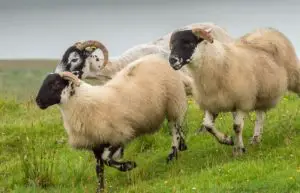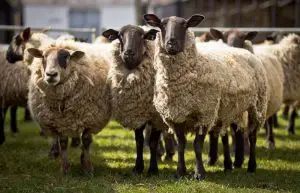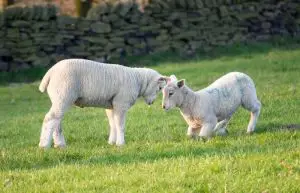
Everything You Need to Know About Sheep Behavior
While sheep may just seem like empty-headed livestock animals, many studies have been done to discover and prove the complexities of sheep behavior and emotions. sheep are prey animals and social animals; these are two main aspects that determine how sheep act and respond to every situation. In this article, I’ll give an overview of basic sheep behavior and how they communicate so that you can better understand your flock.
Sheep Are Prey Animals
The one factor that plays the most part in determining how sheep act and react to things is that they are prey animals. Every part of a prey animal’s nature is designed to help them evade predators and threats that may want to cause them harm. First and foremost, sheep are prey animals. It’s important to remember this as you interact with them since much of their reactions will be based on whether they think you’re a predator or a friend. To learn more about sheep are prey animals, keep reading.
Common Predators of Sheep
As small livestock animals, sheep are more susceptible to predators compared to larger livestock like cattle and horses. While sheep can run and flee, there’s very little they will do to protect themselves from threats. Here is a list of the common predators that like to eat sheep for supper:
- Wild dogs
- Wildcats
- Coyotes
- Bears
- Mountain lions
- Wolves
- Bobcats
- Eagles
While sheep may be more susceptible to predators, there are some things you can do to help give them an extra level of protection. One thing you can do is invest in a livestock guardian animal. Livestock guardians are animals known to protect flocks of sheep and fight off predators that may try and come near. Some of the best livestock guardian animals include large dogs, donkeys, and llamas. To learn more about livestock guardian animals, check out my article What Are the Best Livestock Guardian Animals?
Sheep Anatomy as Prey Animals
As prey animals, the anatomical design of sheep enables them to stay alert and aware of danger while also being able to flee and move quickly if need be. These attributes enable sheep to survive and thrive even as prey animals. Here are some features of sheep that help them survive as prey animals:
Monocular Vision
Animals with monocular vision usually have eyes on the side of their head. This enables them to see almost 360° around them, giving them an enhanced ability to watch for threats of danger. Animals with monocular vision can also control their eyes separately, having one eye look one way and the other eye look the other way.
Excellent Hearing
Sheep have exceptionally good hearing. Most prey animals have large ears that enable them to capture more sound. Their ears can rotate rapidly to gather information and noise. Ears on opposite sides of the head can also capture sounds coming from different directions. This can help sheep stay more alert for unfamiliar noises.
Cloven Hooves
Sheep have cloven hooves, meaning that their hooves are split into two separate toes. Hooves enable sheep to propel themselves forward if they have to flee from danger. Cloven hooves also enable them to quickly walk over uneven surfaces and stay balanced.
Sheep Are Flight Animals
No, sheep can’t fly. But, when it comes to fight or flight, they will definitely choose flight. The most heavily relied upon way that sheep will escape predators is by fleeing. Whether it’s an attacking predator, an unfamiliar human, or a loud noise, a sheep’s instinct will be to run away.
Because of the flight instinct, sheep will naturally be jumpy and wary. If you have recently purchased new sheep and they seem unsure of you, it’s because they haven’t decided whether they see you as a threat or as a friend.
Sheep Have Flocking Instinct
Prey animals tend to live in social groups that provide them with more awareness and protection from predators. By living in a group, sheep are able to keep more eyes and ears open for predators. A predator is less likely to attack a group of animals, but will instead go for stragglers that don’t rely as much on the social environment.
Sheep will feel safer with a group of other sheep or livestock animals. When you look at sheep out in a pasture, you may notice how close together all the animals tend to stay, even if they are grazing or resting. Sheep understand the concept that they are stronger together.
Sheep Are Social Animals
 Another aspect that plays an important role in the behavior of sheep is the fact that they are social animals. While this factor does stem from the prey animal classification that sheep have, it does play a major role in their lives as well. Many studies have been done to learn about the complex emotions that sheep have and the bonds they form with each other. A large portion of the behavior your sheep displays will be based on their social nature and attachment to their flock. To learn more about the social characteristics of sheep, keep reading.
Another aspect that plays an important role in the behavior of sheep is the fact that they are social animals. While this factor does stem from the prey animal classification that sheep have, it does play a major role in their lives as well. Many studies have been done to learn about the complex emotions that sheep have and the bonds they form with each other. A large portion of the behavior your sheep displays will be based on their social nature and attachment to their flock. To learn more about the social characteristics of sheep, keep reading.
Sheep Live in a Flock
As mentioned in the previous section, sheep have a strong flocking instinct that provides them with security and protection from predators. Because of this instinct, sheep tend to live in a group with other sheep known as a flock. In a flock, the sheep will stick closely together, as predators will be more apt to pick off stragglers than they will be to attack the main flock.
Oftentimes, where one sheep goes, the others will follow. Smart sheep will learn to stay close to the flock, no matter where the flock is going. When one sheep starts heading to the water tub to get a drink, the rest of the sheep will follow suit. This can be useful when you have to move your sheep from one place to another, as you just have to lead one sheep and the rest will follow!
Sheep Have Maternal Bonds
It’s not unusual for sheep to recognize their dam (mother) or siblings even after living separated for years. The reason for this is that lambs go through an imprinting process within the first few days of their lives. Imprinting is when a lamb forms an intensely strong bond with the animals it interacts with as a newborn. Through the bond, the lamb will have a strong trust and attachment to this animal or human.
Since a newborn lamb usually interacts the most with its mother in the first few days of its life, it will imprint on its dam. If a lamb is hand-raised by humans, it could imprint on a human and come to trust humans more than it would its own species.
Either way, this close bond enables sheep to recognize and remember each other years down the line. If kept in a pasture with their mother or siblings, you’ll notice that sheep will tend to graze alongside their family members rather than sheep they weren’t raised with.
You Should Have 4 – 5 Sheep to Provide a Flock Community
Since the flock is such an important aspect of a sheep’s life, you may be wondering how many sheep are needed to provide a flock community. If you plan on raising sheep, you will need to provide your sheep with a group that will make the sheep feel secure and protected.
To maintain a proper flock setting, you should have at least 4 – 5 sheep. With this number, the size of the flock can deter predators from coming closer and provide the sheep with plenty of social interaction. In this setting, sheep will form a close bond with each other and stay together no matter where they go.
A Sheep Should Not Be Kept By Itself
Since it’s in a sheep’s nature to live in a flock, you should not keep a sheep by itself. This can cause severe stress, anxiety, and depression in your animal, and should be avoided at all costs. Without companions, a sheep will feel more vulnerable to danger and will become more jumpy and wary.
With all that said, sometimes a sheep will need to be separated from the flock for medical purposes. If that’s the case, keep the sheep somewhere that they are able to see other sheep. This can help them still feel apart of the flock even though they are isolated from the other sheep.
To learn more about why you should not keep a sheep by itself, read my article Can You Keep a Sheep By Itself? Essential Guide.
Sheep Can Co-Exist With Other Livestock Animals
Besides being social with each other, sheep can be very social with other livestock animals. Many farmers like sheep because they can easily co-exist with other smaller and larger livestock. Sheep are known to get along well with goats, cows, and horses. Sheep are often gentle and passive, so they tend to stay out of the way of the larger livestock animals.
Other farm animals can be used to provide a group atmosphere where your sheep can feel safe. Keeping sheep in with larger livestock animals may do even more to deter predators, as most predators won’t approach a group of large livestock. Other animals can also provide the social setting your sheep need to feel safe and connected.
How Do Sheep Communicate?
 Since sheep can’t talk, they must use other means of communication. The most common ways sheep communicate with each other and humans is through body language and vocal cues. When it comes to raising sheep, being able to recognize what your sheep are trying to communicate can enable you to take better care of them. Here is a list of sheep communication terminology you should know:
Since sheep can’t talk, they must use other means of communication. The most common ways sheep communicate with each other and humans is through body language and vocal cues. When it comes to raising sheep, being able to recognize what your sheep are trying to communicate can enable you to take better care of them. Here is a list of sheep communication terminology you should know:
Bleat: a vocalization often used to communicate hunger or to locate other sheep. This is the common “baaing” sound normally associated with sheep. You may also hear this call when sheep are distressed or isolated.
Charge: often a sign of aggression, this is when sheep will lower their heads and run towards a threat, whether it’s you, another sheep, or a dog. This move is often used by dominant sheep as they try and move other sheep away from food or a mate.
Headbutt: this is when a sheep will hit another with its head. You can see this behavior as young lambs play or as rams try to establish dominance over one another.
Pawing: sheep will paw each other to signal they want the other to move out of the way. This can be a sign of dominance. Rams will also paw ewes before mating.
Rumble: a ram or a ewe will make this low gurgling sound when trying to attract a mate.
Snort: this is a vocalization that usually demonstrates frustration or agitation in sheep. You’ll see sheep snort when they’re surrounded by flies or if they’re annoyed with another sheep in their flock.
To learn more important sheep terminology, check out my article Essential Sheep Terms: Sheep Terminology Reference Guide.
There are many other ways sheep communicate other than the words listed above. One of the most important things to be aware of is how calm and relaxed your sheep seem. If there is something wrong, you can usually tell by the way your sheep acts. An anxious or distressed sheep will pace, bleat often, and could stop eating. Lethargy and stiffness could be another sign of an underlying problem. If you notice these behaviors, you should try and figure out why your sheep are acting in such a manner.
Can Sheep Bond With Humans?
Since sheep tend to have such a strong bond with each other and the sheep in their flock, you may be wondering if a sheep is able to bond with a human. This happens more often than you think. lambs that are hand-raised by humans will learn to rely on humans for their needs and can even imprint on their caretaker. While imprinting will form cause the sheep to form a strong bond with their caretaker, it can also make it more difficult for them to assimilate back into a flock and live alongside sheep instead of humans.
Sheep can also form attachments to their handlers. They will learn to recognize the person who feeds them. They will also grow more fond and trusting of people they see on a regular basis. Animals learn by repetition, so the more sheep see you and spend time with you, the more they’ll start to learn you’re not a threat.
Sheep are known to have dog-like behavior once they learn to trust their handlers. When you walk into the field, they may come running over with their tails wagging, expecting a pat or a treat. Nothing will make you feel as good as your flock greeting you at the gate!
Are Sheep Smart?
Sheep are often thought of as empty-headed animals, constantly worried and running away from danger. That, however, could not be further from the truth. While sheep don’t have the intelligence level of humans, many studies have been done to prove how smart sheep really are. Here are some interesting facts about the intelligence of sheep:
Sheep Can Recognize Facial Expressions
Studies show that sheep are able to recognize the facial expressions of their human caretakers. With the ability to recognize facial expressions comes a limited understanding of human emotion, but an understanding nonetheless. This means they are able to tell whether you are happy or sad just based on the expression on your face. This will often time cause them to change their emotion in response.
Sheep Grieve Over Death of A Flock Member
Sheep are known to grieve over the loss of their offspring or other flock members. Sheep will often return to the area of the deceased sheep, even after the body has been removed. They may also act frantic at the time of death, returning to the body to check for any sign of life.
Sheep Can Be Trained
Believe it or not, but sheep can be trained. Sheep are often trained to be led by a halter and lead rope. Sheep are often known to be especially responsive to clicker training. You can teach many things with clicker training, from teaching your sheep to accept human contact to having them perform fun tricks! Sheep can also learn their name and recognize the voice of their handler.
Sheep are complex animals that have a wide range of emotions and behaviors. Mistaking sheep for simple creatures can deter you from taking proper care of your animals. Before you invest in a sheep flock, it’s important to familiarize yourself with how sheep communicate and why they behave the way they do.
We have many articles about how to care for your sheep. If you’re looking for more reading material, check out the articles below!
- How to Care For Sheep: Essential Guide For Beginners
- How Many Sheep Should You Have Per Acre? Essential Guide
- Can You Bathe a Sheep? What You Need to Know

